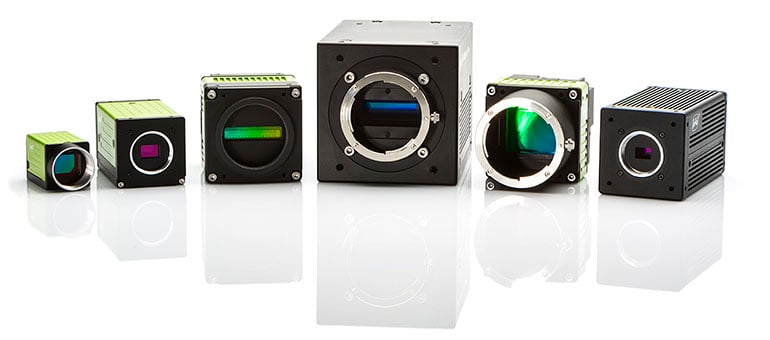
When searching for a new camera for your machine vision application, you will have a lot of options to choose from. Before beginning to evaluate all these different camera options, you have to determine if the application is more suited to an area scan or a line scan type of camera. But what are the differences between these two types of cameras? This blog explains the differences between area scan and line scan color cameras.
Area scan color cameras
An area scan camera is typically used when the items that are being inspected, sorted, or analyzed have definite shapes or boundaries. For example, when you need to inspect individual, 3-dimensional items like fruit, boxes or printed circuit boards, an area scan camera, which uses a matrix of pixels to create a 2D image of each object, will most likely be your choice.
In some situations, area scan cameras can be used for imaging of continuous, moving objects but only by capturing discrete overlapping images. This may require considerable processing effort to “stitch together” the pieces for proper analysis.
Area scan cameras can create an image of a defined area very quickly. Area scan cameras are easier to set-up and install than line scan cameras and serve a more general purpose.
Need help selecting the right color camera for your application?
Download our Tech Guide: Color Imaging, and walk through the steps of selecting the right color imaging camera for your application.
Line scan color cameras
Line scan cameras are most effective when you need to inspect long, continuous items, or a variety of items that have many different lengths or sizes. When the object does not have a well-defined start, end, or even size to it, a line scan camera is most suitable for your application.
For example, for so-called “web” inspection, when you need to inspect rolls of paper, textiles or steel, a line scan camera is the obvious choice. Likewise, conveyor systems filled with randomly arranged fruit or produce, or aerial imaging flying over forests or farmlands are good candidates for line scan cameras. A line scan camera scans moving objects by repeatedly capturing a single line of pixels at a high-frequency.
The continuous “linear images” that the camera captures can be analyzed instantaneously as they are captured, or can be reconstructed line-by-line by software into larger images for analysis.
Because they operate continuously, line scan cameras have a vertical resolution that is effectively “unlimited” and can easily construct two dimensional images with much greater total resolution than area scan cameras.
Which camera best suits your machine vision application?
Need help selecting the right color imaging camera for your application? Read our Tech Guide: Color Imaging, and walk through several steps to select the right color imaging camera for your application
